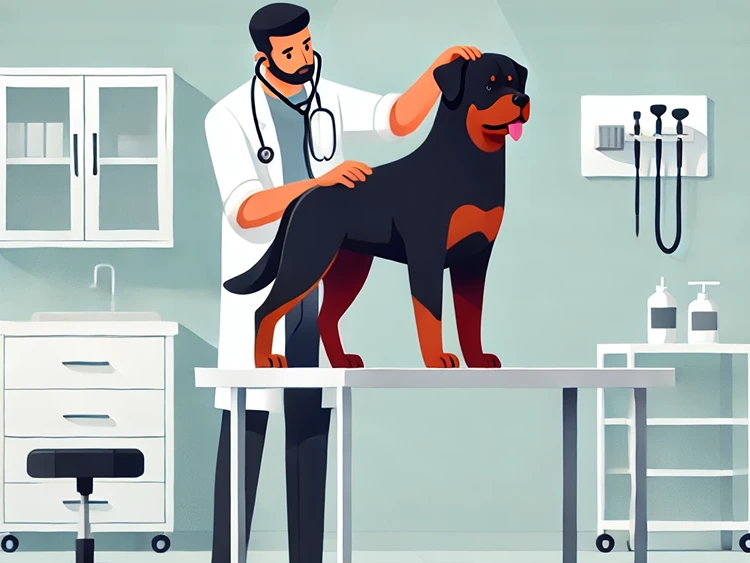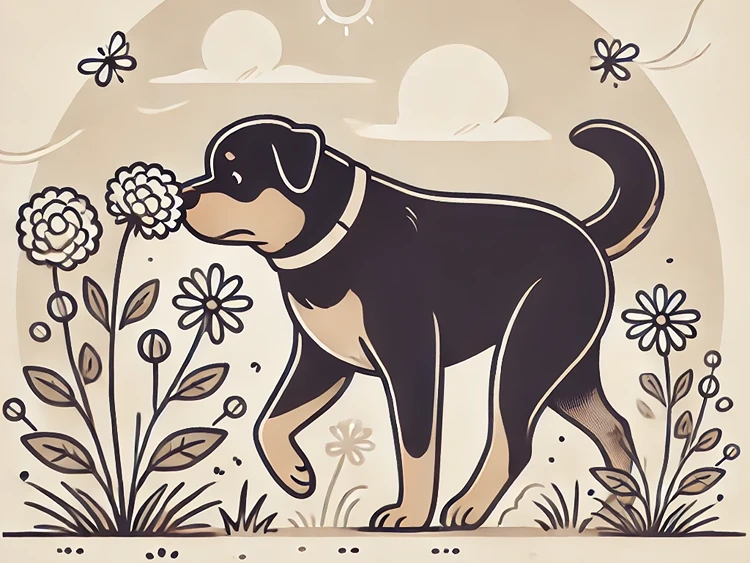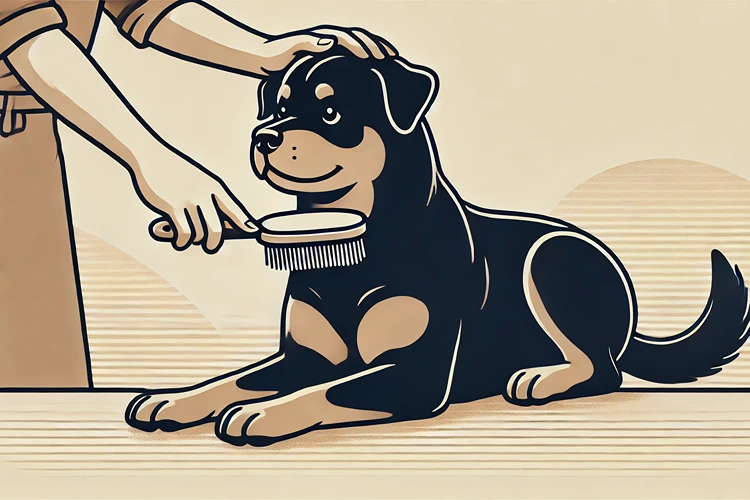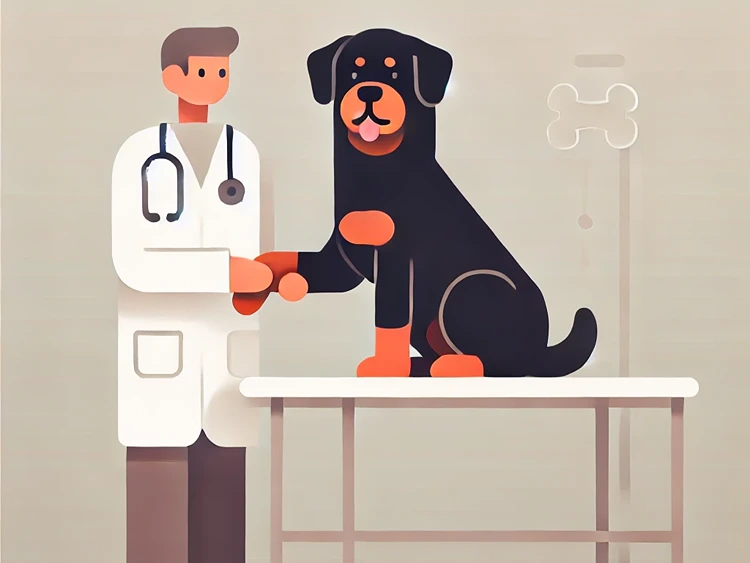Rottweilers are known for their strong build, loyalty, and affectionate nature. However, like all breeds, they are prone to certain skin conditions that can affect their health and well-being. Recognizing and managing these skin issues is essential for keeping your Rottweiler happy and healthy. This article will explore some of the most common skin conditions in Rottweilers and provide practical tips on how to identify and manage them effectively.
Why Rottweiler Skin Health Is Important
The skin is the largest organ of the body and serves as the first line of defense against environmental threats. For Rottweilers, maintaining healthy skin is not just about appearance—it plays a vital role in their overall health. Poor skin health can lead to discomfort, infections, and a weakened immune system. By understanding the common skin conditions that affect Rottweilers, you can take proactive steps to prevent and treat these issues before they escalate.
What Are the Common Skin Conditions in Rottweilers?
Rottweilers can suffer from a variety of skin conditions, some of which are more common than others. These conditions can be caused by a range of factors, including allergies, parasites, infections, and underlying health issues. Here are some of the most common skin problems that Rottweiler owners should be aware of:
- Allergic Dermatitis
- Hot Spots
- Fungal Infections
- Bacterial Infections
- Parasites like Fleas and Mites
- Autoimmune Skin Disorders
How to Identify Allergic Dermatitis in Rottweilers?
Allergic dermatitis is one of the most common skin conditions in Rottweilers. It occurs when your dog’s immune system reacts to allergens such as pollen, dust mites, or certain foods. Symptoms of allergic dermatitis include excessive scratching, redness, and inflamed skin, often leading to hair loss in affected areas. In severe cases, your Rottweiler may develop secondary infections due to constant scratching.
Paw-some Tip:
If your Rottweiler is scratching more than usual, it might be due to an allergy. Pay attention to the environment and diet to identify potential triggers.
Managing Allergic Dermatitis in Rottweilers
Managing allergic dermatitis involves identifying and eliminating the allergen from your Rottweiler’s environment. You may need to consult with a veterinarian to perform allergy testing and determine the exact cause. Treatment typically includes antihistamines, topical ointments, and sometimes a change in diet. Ensuring your Rottweiler has a clean and allergen-free living space is crucial in preventing flare-ups.
What Are Hot Spots and How Do They Affect Rottweilers?
Hot spots, also known as acute moist dermatitis, are another common skin issue in Rottweilers. These are localized areas of inflamed, infected skin that can appear suddenly. Hot spots are often caused by excessive licking, biting, or scratching at an area due to irritation from allergies, parasites, or other skin conditions.
Identifying Hot Spots in Rottweilers
Hot spots are usually red, moist, and can become quite large if left untreated. They are often very painful and can cause significant discomfort for your Rottweiler. The most common areas where hot spots develop are the head, neck, and hips. If you notice a rapidly growing red patch on your Rottweiler’s skin, it’s likely a hot spot.
Treating and Preventing Hot Spots
Immediate treatment is necessary to prevent hot spots from worsening. Start by gently cleaning the affected area with a mild antiseptic solution. Trim the hair around the hot spot to allow the skin to breathe and apply a topical antibiotic or hydrocortisone cream as prescribed by your vet. Preventing hot spots involves regular grooming, keeping your Rottweiler dry, and addressing underlying causes such as allergies or parasites.
Rottie Stats:
Did you know? Up to 20% of Rottweilers suffer from recurrent hot spots during their lifetime, often linked to underlying allergies.
How Fungal Infections Affect Rottweiler Skin
Fungal infections, such as ringworm, are also common in Rottweilers. Despite its name, ringworm is not caused by a worm but by a fungus. This infection is highly contagious and can spread to other pets and even humans. Symptoms of a fungal infection include circular patches of hair loss, red or scaly skin, and itching.
Recognizing Fungal Infections in Your Rottweiler
Fungal infections can be tricky to identify as they may resemble other skin conditions. The most telling sign is a round, hairless lesion with a red ring around it. These lesions can appear on any part of your Rottweiler’s body, but they are most common on the face, ears, paws, and tail.
Treatment and Prevention of Fungal Infections
Treating fungal infections typically involves antifungal medications, either topical or oral, depending on the severity of the infection. It’s important to keep your Rottweiler’s living area clean and to avoid sharing grooming tools with other pets to prevent the spread of the infection. Regular veterinary check-ups can help catch fungal infections early and prevent them from spreading.
Dealing with Bacterial Infections in Rottweilers
Bacterial infections often develop as a secondary issue, usually after your Rottweiler has scratched or bitten at an area of irritation, creating an entry point for bacteria. These infections can vary in severity and may present as localized abscesses, pyoderma (pus-filled sores), or generalized skin infections.
Identifying Bacterial Skin Infections
Signs of a bacterial infection in your Rottweiler include red, inflamed skin, pus-filled blisters, and a foul odor from the affected area. Your dog may also exhibit signs of discomfort, such as excessive licking or scratching. Bacterial infections can spread quickly, so prompt identification and treatment are crucial.
Paw-some Tip:
Keep your Rottweiler’s skin healthy by regularly checking for any signs of infection, especially if they have a history of skin issues. Early detection can prevent more severe problems.
Treatment Options for Bacterial Infections
Treating bacterial infections usually requires a course of antibiotics, prescribed by your veterinarian. In some cases, topical treatments may also be recommended. Keeping the infected area clean and dry is essential for recovery. Regular grooming and a balanced diet can also help strengthen your Rottweiler’s immune system, making them less susceptible to infections.
How Parasites Affect Rottweiler Skin
Parasites such as fleas, ticks, and mites are common culprits behind skin issues in Rottweilers. These pests not only cause itching and discomfort but can also lead to more severe skin conditions if left untreated.
Recognizing Parasite Infestations
The most common sign of a parasite infestation is excessive scratching, biting, or licking. You may also notice visible signs such as flea dirt, tick attachment, or scaly patches of skin. In severe cases, your Rottweiler’s coat may become dull, and they may develop bald spots or sores.
Managing and Preventing Parasite-Related Skin Conditions
Managing parasite infestations involves using veterinarian-recommended flea and tick preventatives, regularly checking your Rottweiler for signs of parasites, and maintaining a clean living environment. If you suspect a mite infestation, your vet may need to perform skin scrapings to diagnose the issue accurately.
Rottie Stats:
According to a recent study, nearly 30% of dogs in the U.S. experience flea infestations annually, leading to skin problems if not promptly treated.
Autoimmune Skin Disorders in Rottweilers
Autoimmune skin disorders are less common but can be particularly challenging to manage. These conditions occur when your Rottweiler’s immune system mistakenly attacks its own skin cells, leading to chronic inflammation and other issues.
Identifying Autoimmune Skin Disorders
Autoimmune skin disorders can manifest in various ways, including blistering, ulcers, or depigmentation of the skin. These conditions are often diagnosed through a combination of physical examination, skin biopsies, and blood tests. If your Rottweiler shows signs of persistent skin issues that do not respond to typical treatments, an autoimmune disorder may be the cause.
Treatment and Management of Autoimmune Skin Disorders
Managing autoimmune skin disorders usually involves immunosuppressive medications to reduce the immune system’s attack on the skin. In addition, topical treatments may be used to manage symptoms and prevent secondary infections. It’s essential to work closely with your veterinarian to monitor your Rottweiler’s condition and adjust treatments as needed.
Paw-some Tip:
Autoimmune disorders require careful management. Regular vet visits and a tailored treatment plan can help keep your Rottweiler comfortable and improve their quality of life.
How to Keep Your Rottweiler’s Skin Healthy
Maintaining healthy skin in Rottweilers is about more than just treating issues as they arise; it’s also about prevention and ongoing care. A proactive approach can significantly reduce the likelihood of your Rottweiler developing skin conditions in the first place.
Regular Grooming: A Key to Healthy Skin
Regular grooming is one of the most effective ways to keep your Rottweiler’s skin and coat in top condition. Brushing your dog’s coat several times a week helps to remove loose hair, dirt, and debris that can cause skin irritation. It also stimulates the skin’s natural oils, which are crucial for maintaining a healthy, shiny coat.
Paw-some Tip:
Choose a brush that’s appropriate for your Rottweiler’s coat type. A bristle brush works well for short-haired Rottweilers, while a rubber curry brush can help remove loose fur and stimulate the skin.
Diet and Nutrition: Feeding for Skin Health
A well-balanced diet plays a crucial role in maintaining your Rottweiler’s skin health. Ensure your dog is getting the right mix of proteins, fats, vitamins, and minerals. Omega-3 and Omega-6 fatty acids, found in fish oils and flaxseed, are particularly beneficial for skin and coat health.
Consider adding supplements to your Rottweiler’s diet if recommended by your vet, especially if your dog is prone to skin issues. A high-quality, balanced diet not only supports healthy skin but also boosts your dog’s overall immune system, making them less susceptible to infections and other health problems.
Bathing: When and How Often?
Bathing your Rottweiler is another essential aspect of skin care, but it should be done carefully to avoid over-bathing, which can strip the skin of its natural oils. Aim to bathe your Rottweiler every 4 to 6 weeks, or as recommended by your vet, using a gentle, dog-specific shampoo that won’t irritate the skin.
Be sure to thoroughly rinse out all shampoo to prevent residue that can cause itching and irritation. If your Rottweiler has a skin condition, your vet may recommend a medicated shampoo to help manage the issue.
When to See a Veterinarian for Skin Issues

While many skin conditions in Rottweilers can be managed at home, there are times when a visit to the veterinarian is necessary. If you notice any of the following signs, it’s important to seek professional advice:
- Persistent scratching, biting, or licking that doesn’t improve with home care
- Red, inflamed, or pus-filled sores
- Hair loss in patches or over a large area
- Unusual odors from the skin
- Changes in skin color or texture
- Lethargy or loss of appetite
Your vet can perform diagnostic tests to determine the underlying cause of the skin issue and recommend an appropriate treatment plan. Early intervention can prevent more severe health problems and ensure your Rottweiler remains comfortable and healthy.
Long-Term Care for Rottweiler Skin Health

Maintaining your Rottweiler’s skin health is an ongoing process. In addition to the regular grooming, diet, and bathing routines discussed earlier, consider the following tips for long-term skin care:
Regular Vet Check-Ups
Routine veterinary visits are crucial for keeping your Rottweiler’s skin and overall health in check. Regular check-ups allow your vet to catch potential skin issues early, recommend preventive measures, and adjust your care routine as needed.
Environmental Considerations
Your Rottweiler’s environment can significantly impact their skin health. Ensure your dog has a clean, comfortable living space free from allergens like dust and mold. If your Rottweiler spends a lot of time outdoors, regularly check for ticks, fleas, and other parasites that could cause skin problems.
Managing Stress
Believe it or not, stress can affect your Rottweiler’s skin. Dogs under stress may be more prone to scratching or licking excessively, leading to skin issues. Ensure your Rottweiler has plenty of exercise, mental stimulation, and a calm environment to reduce stress levels.
Protecting Against the Elements
Weather conditions can also affect your Rottweiler’s skin. In colder months, dry air and cold winds can lead to dry, flaky skin. In contrast, the summer sun can cause sunburn or heat rashes. Consider using a dog-safe sunscreen in summer and ensuring your dog stays hydrated. In winter, moisturizing balms can help protect against dry skin.
Seasonal Skin Care Tips for Rottweilers
| Season | Skin Care Tip |
|---|---|
| Spring | Watch out for seasonal allergies. Rinse your Rottweiler’s paws after walks to remove pollen. |
| Summer | Apply dog-safe sunscreen to exposed skin areas and ensure your dog stays hydrated to prevent heat rashes. |
| Fall | Increase grooming frequency to remove shedding fur and reduce the risk of fungal infections. |
| Winter | Use moisturizing balms on your dog’s paws and skin to combat dryness caused by cold weather. |
FAQs
Wrapping Up
Maintaining your Rottweiler’s skin health is an ongoing responsibility that goes beyond addressing issues as they arise. By understanding the common skin conditions that Rottweilers face, and taking proactive measures through regular grooming, a balanced diet, and timely veterinary care, you can prevent many of these problems before they start. Remember, your Rottweiler’s skin is a reflection of their overall health, and keeping it in top condition is key to their happiness and well-being. Stay vigilant, provide the care they need, and your Rottweiler will continue to thrive.



